Trigger warning for all vampires — look away and avoid the urge to count. Continue reading and be stuck with numbers for a while!
Did you encounter a vampire this Halloween? If you missed your chance, you can still learn about vampire numbers in math.
A vampire number is a number that can be written as the product of two numbers (fangs) of the same length where all the digits of the vampire number are present in the fang numbers. Let’s look at an example.

It is clearly visible here that the vampire number (1,260) can be written as the product of two equal-length numbers, its fangs (21 and 60), which contain the same digits (2, 1, 6, 0) as the vampire number. However, there is a catch. A number cannot be categorized as a vampire number if its fangs contain trailing zeroes.

There are numerous examples of vampire numbers. Some are more interesting than others. Let’s look at some interesting examples.
117,067 = 167 x 701
The interesting feature of this example is that the vampire number and its fangs are all prime numbers, making 117,067 a prime vampire number.
13,078,260 = 1,620 x 8,073
Or
1,863 x 7,020
Or
2,070 x 6,318
In this example, the vampire number has three unique pairs of fangs.
For our last example, let’s think outside the box. Do vampire numbers exist only in cardinal numbers? How about other representations of numbers? Let’s take a look at some Roman numerals.
VIII = II * IV
There are many vampire numbers that exist. How many vampire numbers can you find? How many Roman numeral vampire numbers can you find?
Bonus fact about vampires: According to traditional folklore, vampires are considered to suffer from arithmomania, an obsessive compulsion to count. This is the joke behind the Count von Count (known simply as The Count) on Sesame Street who counts everything he sees and when he is alone, counts himself.






